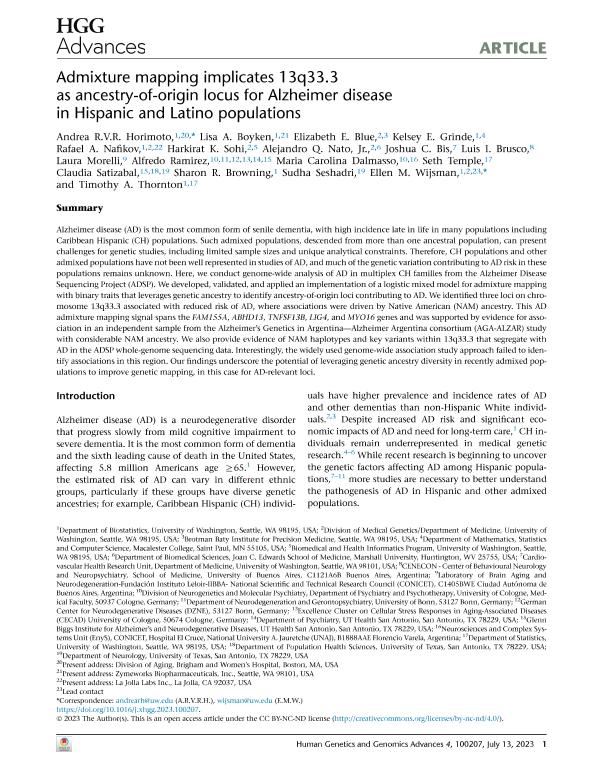Artículo
Admixture mapping implicates 13q33.3 as ancestry-of-origin locus for Alzheimer disease in Hispanic and Latino populations
Horimoto, Andrea R.V.R.; Boyken, Lisa A.; Blue, Elizabeth E.; Grinde, Kelsey E.; Nafikov, Rafael A.; Sohi, Harkirat K.; Nato, Alejandro Q.; Bis, Joshua C.; Brusco, Luis Ignacio ; Morelli, Laura
; Morelli, Laura ; Ramirez, Alfredo Jose; Dalmasso, Maria Carolina
; Ramirez, Alfredo Jose; Dalmasso, Maria Carolina ; Temple, Seth; Satizabal, Claudia; Browning, Sharon R.; Seshadri, Sudha; Wijsman, Ellen M.; Thornton, Timothy A.
; Temple, Seth; Satizabal, Claudia; Browning, Sharon R.; Seshadri, Sudha; Wijsman, Ellen M.; Thornton, Timothy A.
 ; Morelli, Laura
; Morelli, Laura ; Ramirez, Alfredo Jose; Dalmasso, Maria Carolina
; Ramirez, Alfredo Jose; Dalmasso, Maria Carolina ; Temple, Seth; Satizabal, Claudia; Browning, Sharon R.; Seshadri, Sudha; Wijsman, Ellen M.; Thornton, Timothy A.
; Temple, Seth; Satizabal, Claudia; Browning, Sharon R.; Seshadri, Sudha; Wijsman, Ellen M.; Thornton, Timothy A.
Fecha de publicación:
07/2023
Editorial:
Cell Press
Revista:
Human Genetics and Genomics Advances
ISSN:
2666-2477
Idioma:
Inglés
Tipo de recurso:
Artículo publicado
Clasificación temática:
Resumen
Alzheimer disease (AD) is the most common form of senile dementia, with high incidence late in life in many populations including Caribbean Hispanic (CH) populations. Such admixed populations, descended from more than one ancestral population, can present challenges for genetic studies, including limited sample sizes and unique analytical constraints. Therefore, CH populations and other admixed populations have not been well represented in studies of AD, and much of the genetic variation contributing to AD risk in these populations remains unknown. Here, we conduct genome-wide analysis of AD in multiplex CH families from the Alzheimer Disease Sequencing Project (ADSP). We developed, validated, and applied an implementation of a logistic mixed model for admixture mapping with binary traits that leverages genetic ancestry to identify ancestry-of-origin loci contributing to AD. We identified three loci on chromosome 13q33.3 associated with reduced risk of AD, where associations were driven by Native American (NAM) ancestry. This AD admixture mapping signal spans the FAM155A, ABHD13, TNFSF13B, LIG4, and MYO16 genes and was supported by evidence for association in an independent sample from the Alzheimer's Genetics in Argentina—Alzheimer Argentina consortium (AGA-ALZAR) study with considerable NAM ancestry. We also provide evidence of NAM haplotypes and key variants within 13q33.3 that segregate with AD in the ADSP whole-genome sequencing data. Interestingly, the widely used genome-wide association study approach failed to identify associations in this region. Our findings underscore the potential of leveraging genetic ancestry diversity in recently admixed populations to improve genetic mapping, in this case for AD-relevant loci.
Archivos asociados
Licencia
Identificadores
Colecciones
Articulos(IIBBA)
Articulos de INST.DE INVEST.BIOQUIMICAS DE BS.AS(I)
Articulos de INST.DE INVEST.BIOQUIMICAS DE BS.AS(I)
Articulos(SEDE CENTRAL)
Articulos de SEDE CENTRAL
Articulos de SEDE CENTRAL
Citación
Horimoto, Andrea R.V.R.; Boyken, Lisa A.; Blue, Elizabeth E.; Grinde, Kelsey E.; Nafikov, Rafael A.; et al.; Admixture mapping implicates 13q33.3 as ancestry-of-origin locus for Alzheimer disease in Hispanic and Latino populations; Cell Press; Human Genetics and Genomics Advances; 4; 3; 7-2023; 1-15
Compartir
Altmétricas



